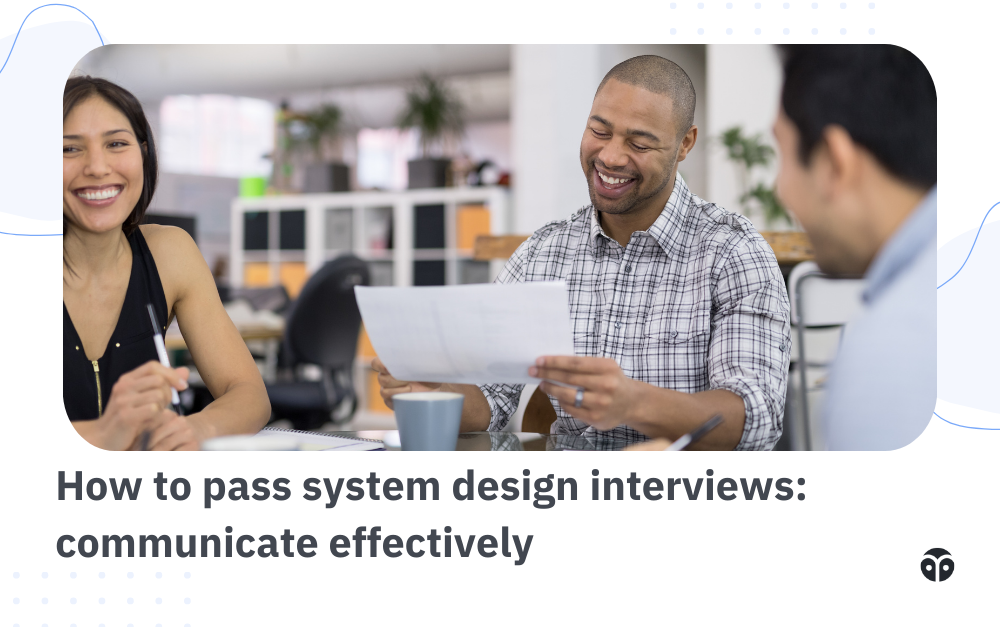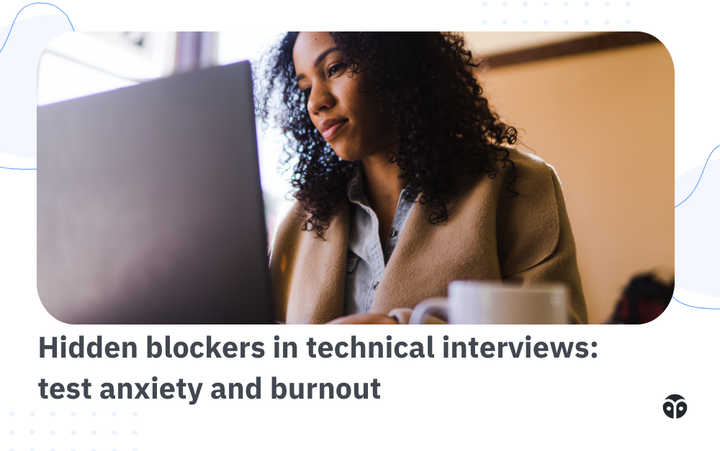How to pass system design interviews: communicate effectively
Learn strategies to stay clear, structured, and confident in your system design interview.

System design interviews are known for being tough. They test your ability to approach complex problems and gauge how well you can explain your ideas and decisions. Even candidates with excellent technical knowledge can struggle if they don’t communicate effectively.
Clear communication is essential to navigating system design interviews. It’s not enough to know the right answers; you need to guide the interviewer through your thought process, ask the right questions, and justify your decisions.
Whether you’re clarifying the prompt, documenting your ideas, or explaining your decisions, strong communication keeps the conversation focused and productive.
Why communication matters
Think of communication as the bridge between your ideas and the interviewer’s understanding. If you can’t explain your thought process clearly, it’s hard for the interviewer to evaluate your solution. Poor communication can make even the best ideas seem confusing or incomplete, while strong communication can make a simple solution shine.
System design interviews are deliberately open-ended, leaving room for interpretation. This means you’ll need to actively engage with the interviewer to define the problem, refine your approach, and adapt to feedback. Without effective communication, even the best technical skills can go unnoticed.
Common communication pitfalls
System design interviews test more than your ability to think through technical problems—they assess how well you can articulate your ideas and reasoning. Balancing technical depth with clear communication is no easy task, and even well-prepared candidates often fall into these common traps:
- Freezing in the spotlight
- Failing to document your ideas
- Making decisions that seem arbitrary
The good news is that each of these challenges has a clear and actionable solution. By mastering the right strategies, you’ll not only communicate your ideas effectively but also stand out as a confident and collaborative problem-solver. Let’s dive into how to approach your system design interview with clarity, structure, and purpose.
Strategies for effective communication
Clear communication requires practice and a structured approach. These strategies will help you convey your ideas confidently and collaboratively:
1. Keep moving forward: ask questions
It’s easy to feel stuck when presented with a big, open-ended problem. Freezing or going silent while you think is a common reaction. However, long pauses can make you seem unsure of how to proceed. Instead, use questions to maintain momentum and engage with the interviewer.
If you’re not sure where to start, begin by clarifying the problem. For example, if you’re designing a hotel reservation system, ask:
- What’s the scope of the system? Is it for one hotel chain or a larger platform?
- How far in advance can users book? Does the system need to handle bookings years out or just within a year?
- How do reservations work? Are users reserving specific rooms or room types?
These questions help you gather the information you need while demonstrating a structured approach to problem-solving. If you’re unsure what to ask, focus on the user’s experience. For instance, “What steps does the user go through when making a reservation?” Mapping out the user journey will naturally guide you toward identifying the key requirements of the system.
The goal is to keep the discussion flowing. Asking thoughtful questions shows you’re engaged and helps the interviewer see how you approach a problem.
2. Write it down: document your thinking
Explaining your ideas verbally is helpful, but it’s much clearer when paired with written or visual aids. Many candidates overlook this and rely entirely on spoken communication, which can lead to misunderstandings or confusion. Writing things down helps both you and the interviewer stay aligned throughout the discussion.
As you outline your solution, document key steps or components using diagrams, lists, or bullet points.
For example, when tackling a hotel reservation system, you might break it down like this:
- The user enters a location and date range.
- The system identifies available properties in that area.
- It checks which room types are free for the selected dates.
- The user selects a property and room type to proceed to checkout.
- The system temporarily holds the room type during checkout.
- Upon payment, the system finalizes the booking and updates availability.
Writing out these steps makes your process easy to follow and helps you organize your thoughts. It also allows the interviewer to provide immediate feedback on your approach. Additionally, it creates a clear reference for both you and the interviewer, so any adjustments can be made without confusion.
Visual aids like flow diagrams or system architecture sketches can also enhance clarity. Whether you’re listing requirements or mapping interactions between components, documenting your design keeps the conversation on track.
3. Make it clear: explain your decisions
Choosing technical solutions without explaining the reasoning behind them can lead to missteps. For example, deciding to use a NoSQL database without considering other options might seem arbitrary. Thoughtful decision-making involves weighing trade-offs and aligning your choices with the system’s requirements.
Start by identifying what the system needs to do and use that as a guide for your decisions. For instance, when deciding on a database for reservations, consider:
- Will the system need to handle complex queries? If you need to filter reservations by date or location, a relational database might work better.
- Do you need fast lookups by reservation ID? A NoSQL database could provide quick, simple access.
By explaining your reasoning, you show that your choices are deliberate and informed. If you’re unsure about a decision, talk through the pros and cons. For example, you might say, “If we use NoSQL, it’s great for quick lookups, but it might make filtering by date more difficult. A relational database could handle both well, but it could introduce some latency.” This gives the interviewer insight into your thought process and shows that you’re considering the broader implications of your decisions.
Thinking out loud also helps you spot potential issues and gives the interviewer an opportunity to discuss alternatives with you. The more you show your reasoning, the more confident you appear in your approach.
The do’s and don’ts of system design communication
Do: Ask questions early
Clarify the scope and requirements before diving into solutions. For example, confirm whether you’re designing a feature or an entire platform.
Don’t: Rely only on verbal explanations
Use written or visual aids to structure your ideas and keep track of progress.
Do: Justify your decisions
Explain why you chose a particular tool, architecture, or approach. This shows you’re deliberate and thoughtful in your design process.
Don’t: Skip over key details
Avoid arbitrary choices. If a decision isn’t worth defending, it might not be worth mentioning.
Get holistic interview prep with Formation
The Formation Fellowship gives mid-level and senior engineering job seekers everything they need to land their dream roles—including personalized skill brush-ups, resume help, unlimited mock interviews with experienced software engineers and hiring managers from top-tier tech companies, career and negotiation support, and more.
If you’re having trouble navigating your job search on your own, apply here and get unconditional support from a team of engineering mentors, technical recruiters, career coaches, and more.



